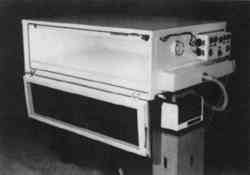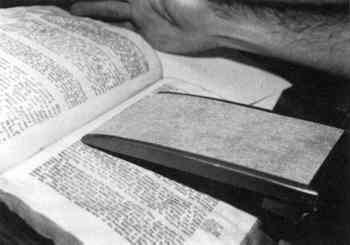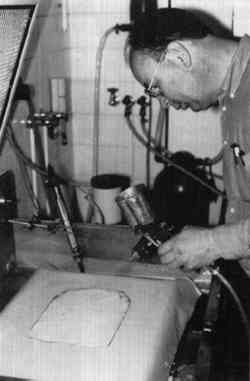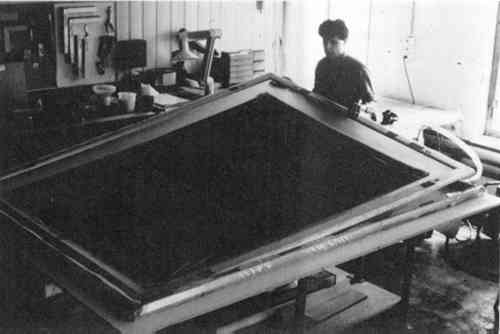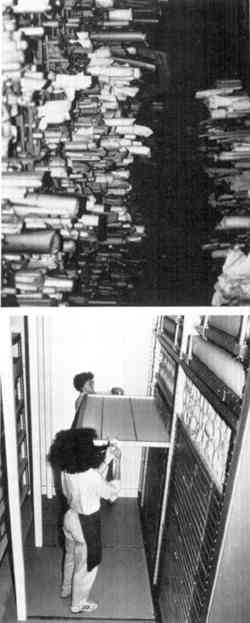OBSERVATIONS ON DEVELOPMENTS IN THE TREATMENT OF WORKS ON PAPERT. K. McCLINTOCK
ABSTRACT—An informal survey of paper conservators yielded developments in treatment of interest for summary and presentation to other conservation specialties. These developments include: the improved quality and relevance of scientific research; an appreciation of systematic gradations of treatment; repairs with paper pulp; concerns about local treatment procedures; the traditions of the Japanese mounter; limiting treatments; and large-scale and group treatments. 1 INTRODUCTIONDuring the Book and Paper Specialty Group Update Session at the 1988 annual meeting of the American Institute for Conservation, Leslie Kruth discussed the most compelling issues at that time in the specialty of paper conservation (Kruth 1988). Included were the methodology of scientific research, bleaching, wash water quality and deacidification, encapsulation, and fumigation. To this foundation other topics of interest can be added three years later that continue a focus on the treatment of artifacts. These topics were derived from a broad, informal survey of paper conservators and were highlighted specifically for their value in generating discussion about the particulars of paper conservation and the shared concerns of other conservation specialties. 2 QUALITY OF RESEARCHTo continue the focus of the article “Recent Scientific Research in Paper Conservation” (van der Reyden 1992), the symbiotic relationship between scientific research and conservation practice is important and fruitful. Works on paper are distinguished by the interrelationship of fragile design media and a highly impressionable fiber matrix support. Any material introduced or procedure undertaken can have a whole and lasting impact on the appearance and condition of the work. For example, while carrying out a treatment the conservator may observe empirically that washing promotes suppleness or that stain reduction with light seems more gentle than with chemical bleaching agents. Our research colleagues may not only confirm these qualitative observations, but they may also through more quantitative methods assist the conservator in comparing alternative procedures or in determining optimum lengths of time for a procedure to be effective. Because conservators seek to minimize the element of risk during treatment, such research with bases in genuine practice has been given great currency. 3 GRADATIONS OF TREATMENTThe desire to minimize risk has led to an interest in how treatments can be gradated, particularly with solvents and moisture. Water is probably the single most effective tool available to paper conservators. It is critical for cleaning, reducing planar distortions, reversing many adhesives, restoring suppleness to paper, and repairing or reinforcing a sheet. Full immersion in water dramatically illustrates both the extent of treatment that may be possible and the necessity Because GoreTex allows the unidirectional passage of water vapor and has a very smooth surface, it makes possible the extremely controlled introduction of moisture even to objects with a fragile or loaded surface. Humidification can take place by dampening the fibrous reverse side, under damp blotters or within a dome where vapor has been introduced with an ultrasonic humidifier, generally in preparation for flattening, removing mounts, or conditioning an object before work on a suction table. If washing on the suction table is the objective, the passage of moisture through the GoreTex may still be desirable to minimize oversaturation. GoreTex is also effective for introducing solvents by spray or by saturated blotters. The Lascaux humidity chamber (fig. 1) further refines the introduction of moisture to a controlled level of humidity over prolonged periods.
Small suction discs and plates capable of great pressure are now widespread and tailored to specific applications (fig. 2). They have largely supplanted the use of full-scale suction tables for local moisture treatment, and they complement the use of mineral poultices for local solvent treatment. Even when used with moisture in a form as discrete as vapor, worthwhile changes can be effected. Concerns that artifacts on suction tables serve, in effect, as filters in a less than pure environment have been addressed by the incorporation into consoles of air intake filters and, in the most comprehensive development, of functioning within prefiltered clean rooms.
Still shy of full immersion in water baths are the numerous refinements of float washing systems to promote additional control while drawing out water-soluble discoloration or degradation products. Blotters set on an incline saturated with running water channeled underneath act as an effective washing bed. Another system involves supporting the humidified object on a matched pair of screens that face each other, allowing the water to be raised to a level precise enough to achieve saturation of the object, and then pulling the screens apart regularly to draw the discolored solution out of the sheet. A more clear understanding of the length of exposure to water that is necessary to achieve cleanliness or to remove agents introduced allows The research directed at the wetting of sheets has also promoted interest in the related subject of flattening. Uniformity of response is the objective whereby, even after limited humidification at one extreme or full saturation at the other, the edges and interior of the sheet dry at the same rate. One of the more imaginative approaches has been the use of acid-free corrugated sheets with mat board adhered to both sides. Objects are interleaved in a stack under pressure and with air directed through the channels to accelerate evaporation of the moisture wicked through the boards. 4 PULP REPAIRSThe hand paper makers in America, Great Britain, and Japan have been very responsive to the needs of conservators in developing an assortment of Asian and Western-style sheets for use in mending, filling, lining, and mounting. Despite these resources, there will always be a dearth of historic or contemporary samples for repairs that achieve the perfect match of color, texture, thickness, and opacity. Paper pulp addresses that need when filling a loss, with the additional advantage that pulp often bonds better to the edges of a loss and is easier to manipulate into small locations or those reduced in thickness by skinning. The edges of tears can be fibrillated while wet to clean them and achieve better integration of mends or fills, for which a hand-held electric engraving tool fitted with a splayed bamboo stick has proved useful. Spot filling, a variation on leaf casting, is possible over a suction table, plate, or disc. If the object is intolerant of moisture, papers may also be cast in organic solvents or in small amounts to be dried and used as fill material. Templates have been made with silk-screen resist on polyester web to simulate the patterns of textured papers. The thinnest of sheets can be leaf cast, brushed with nonaqueous adhesives, dried, and applied with solvents for local reinforcement over text or image. As an alternative to lining, attempts have been made in the Netherlands to incorporate adhesives into pulp for spraying over sheets in need of very transparent reinforcement (fig. 3). Color matching has generally been achieved by mixing pulp from sheets of assorted colors or inpainting after drying. Following the lead of hand paper makers, efforts at coloring the pulp in the original furnish are being made with cationic polyamine retention agents and
5 LOCAL TREATMENTSAnother development of interest is a concern for the local as opposed to the overall introduction of moisture and solvents or the agents for which they serve as vehicles, such as bleaches, enzymes, and alkaline agents. The premise is that if local areas of a sheet of paper are treated differently, with age a different condition or appearance may result. Despite the use of very limited moisture, soluble substances may move about a sheet and deposit in a tideline not visible in normal viewing conditions but plainly visible under ultraviolet light. The introduction of very focused steam pencils facilitates the local removal of adhesives without having to resort to enzymes or more saturating poultices. For the same reasons, efforts are made to minimize the need for solvents. Hot-air pencils followed by crepe or high solvent-content erasers are very effective in the removal of self-adhesive tapes. Residual adhesives can also be exposed to solvent fumes and rolled up with paper pulp. 6 TRADITIONS OF THE JAPANESE MOUNTERA topic of longstanding interest is the appreciation and adaptation of the materials and techniques used in the workshops of Japanese mounters. The bases of this continued appeal are the integration of materials, tools, and procedures with elegance, versatility, and great applicability to the concerns of Western paper conservators. Cleaning with facings, using fewer adhesives with more understanding of their versatility, multiple linings, stretch drying, and lattice core paper–covered panels for mounts have all found currency. More familiarity has been promoted both by a willingness to share sophisticated observations in publications, conferences, and courses and by increasing Western astuteness. As important is the recognition, as in the care of Western works, that there is not a monolithic sensibility about the treatment of Asian works. Great variations among practitioners are found in the use of fixatives and moisture, inpainting, and the conservation of accessory elements such as brocades. Developments being generated in the West are also finding favor in Japan, such as the use of suction tables, deacidification agents, and cellulose ether and synthetic resin adhesives. 7 LIMITING TREATMENTIt is not oxymoronic to also include in developments a more conscious acceptance of the limitations of treatment. This acceptance should not be confused with an unwillingness on the part of paper conservators to put to use a wealth of collective experience and specialized equipment. Collection surveys have underscored the value of devoting resources to improving housing and environment. In light of the volume of material entering repositories of works on paper, tailored storage is often an effective alternative to treatment or mitigates the need for immediate or more extensive treatment. Producers of archival enclosures have responded by making available products tailored to varied needs of access, dimension, and condition. The radiant heat welder and ultrasonic encapsulator have enabled the production of highly individualized Mylar enclosures uncompromised by the need to use tape as a seal. It is an array for which North Americans are the envy of colleagues overseas. The importance of an acid-free storage environment has been successfully promoted to professional groups with whom conservators have overlapping concerns. A tangential focus has been on the format of the object. Objectively the format may pose some compromise to 8 LARGE-SCALE AND MASS TREATMENTSThe conservation of large individual objects and large groups of objects has received great attention in an attempt to expand the criteria of judgment about what constitutes good and appropriate treatment. In the case of large objects, stumbling blocks have characteristically been overall bathing in water or solvents, flattening, and mounting to systematically address storage, display, and transport. The cost of devoting the same attention to procedures such as stain reduction, filling, and inpainting on a large scale to what would be given to a smaller-sized work has also necessitated compromises. Happily, managers of specialty collections are fostering great appreciation for objects that are characteristically created on a large scale, such as contemporary works, architectural drawings, cartographic records, and historic wallpapers. Funds are being made available to undertake projects with a level of craftsmanship that only time and materials can make possible. Trays and handling systems made of modular stretchers wrapped with polyethylene or permeable screening (fig. 4), large format sinks, and suction tables up to 4 � 6 ft alleviate some of the
In considering the treatment of large groups of objects, it was noted in the discussion of limiting treatment how tailored housing may mitigate or postpone more than basic processing. While limited resources dictate that objects in a large group may receive a single opportunity for treatment, they are nonetheless handled and judged individually, however fleetingly. Humidification in batches to relax planar distortion, flattening between felts or blotters in stacks under weights, surface cleaning, and minimal mending already summarizes an enormous volume of work (fig. 5). To introduce washing is to raise the cost of treatment substantially because of the time necessary to evaluate solubilities by testing and the time and space necessary to process, sort, dry, and flatten. It is interesting to reflect on earlier approaches, such as lamination, to which efforts are now being devoted to reversing. Even promising developments in group treatment—such as mass deacidification, paper strengthening through graft copolymerization, or the introduction of synthetic polymers—are therefore still viewed with caution.
In contrast, reinforcement by splitting weakened sheets and relaminating them with interleaves of Japanese-type paper is a widespread process in Germany. Continuous large-scale batch treatment can be quasi-mechanized, as groups of objects are assembled in rolls, washed and alkalized together, and unrolled for drying. Continuous leaf casting in a seamless stream has been developed in Denmark (fig. 6). Efforts such as these are felt to meet individual institutions' problems of collection condition and size. These treatment methods may be alternatives or supplements to photo-duplication, whereby preservation of the original object is promoted because a reproduction receives the routine consultation.
In the United States the development of leafcasters and associated software with more finesse and nearly the same pace of production has occurred. Nonaqueous soft-spray deacidification systems also make possible more uniform and rapid processing of sheets by minimizing overspray. Educational programs through the Library of Congress, the National Archives, the Society of American Archivists, assorted regional centers, and libraries have promoted the development of technician-level in-house programs for treatment. At the graduate level, programs at Columbia University, Winterthur/University of Delaware, and State University College at Buffalo have given or plan to give focused and deserved attention to the treatment of archives. For the moment, limited resources and the desire to avoid overtreatment at the expense of general preservation have prevented a scale of automation and extent of processing comparable to that found in Europe to be exercised as the primary treatment focus in North America. 9 SUMMARYWhat continue to be nemeses in the treatment of works on paper? Overall consolidation of cleavage, the treatment of mold, the lack of completely satisfactory nonaqueous adhesives, and the costs of treatment deserve attention. For the best review of developments in treatment, readers are encouraged to consult Paper Conservation News and Institute for Paper Conservation Annual from Great Britain, Restaurator from Denmark, Abbey Newsletter from the United States, and the American Institute for Conservation In addition to those topics brought to readers' attention in the papers in this issue on scientific research (van der Reyden 1992) and treatment in libraries and archives (Fredericks 1992), the developments in treatment identified as most current are, in summary:
ACKNOWLEDGEMENTSNumerous paper conservators contributed treatment notes and photographs or reviewed preliminary outlines of this paper to ensure that the information represented some consensus for presentation to conservators with other specialties. Thanks are due to the Update organizers and speakers Victoria Blyth-Hill, Maria Fredericks, Kate Maynor, Sue Murphy, Roy Perkinson, and Dianne van der Reyden. Additional thanks are due to contributors and reviewers Bob Aitchison, Gary Albright, Sylvia Rodgers Albro, Diana Alper, Konstanze Bachman, Lorraine Bigrigg, Craigen Bowen, Silvia Brunetti, Margaret Ellis, Debra Evans, Bob Futernick, Karen Garlick, David Hanington, Robert Hauser, John Krill, Leslie Kruth, Per Laursen, Olivier Masson, Geoffrey Morrow, Frank Mowery, Kitty Nicholson, Antoinette Owen, Pia de Santis Pell, Lois Price, Marjorie Shelley, Judy Walsh, and Mark Watters. REFERENCESFredericks, M.1992. Recent trends in book conservation and library collections care. Journal of the American Institute for Conservaton32:93–99. Kruth, L.1988. A survey of recent scientific research which has caused a re-evaluation of commonly used practises in book and paper conservation. American Institute for Conservation Book and Paper Group Annual7:30–39. van der Reyden, D.1992. Recent scientific research in paper conservation. Journal of the American Institute for Conservation32:117–37. OTHER SOURCESBarrett, T.1989. Early European papers/contemporary conservation papers: A report on research undertaken from fall 1984 through fall 1987. Paper Conservator13:1–108. Futernick, R.1988. New methods, adapted tools and alternate treatments. Abstracts. Symposium 88, Conservation of Historic and Artistic Works on Paper, Canadian Conservation Institute, Ottawa. 21. Hansen, E., and C.Reedy. 1991. Replies to AIC Task Force on Conservation Science Questionnaire to the Book and Paper Group. Unpublished draft manuscript. Keyes, K.1978. The unique qualities of paper as an artifact in conservation treatment. Paper Conservator3:3–8. Mowery, J.F.1991. A stand alone imaging system to assist in leafcasting developed at the Folger Shakespeare Library, Washington, D. C.Restaurator12(2):100–115. Shelley, M.1989. Old Master drawings: An approach to conservation. American Institute for Conservation Book and Paper Group Annual8:62–66. Shores, F.1987. A clean room for a small conservation laboratory. AIC preprints, 15th Annual Meeting, American Institute for Conservation, Washington, D.C.118–23. Stone, J.1987. Treatment of 19th-century tracing papers from the Frederick Law Olmsted collection. Preprints, 8th Triennial Meeting, ICOM Committee for Conservation, Paris. 2:731–38. Wills, P., and N.Pickwood, eds.1985. Hyogu: The Japanese tradition in picture conservation. Paper Conservator9:1–63. MANUFACTURERSHot air pencil, modular stretcher, humidity chamberLascaux Farkenfabrik, Alois K. Diethelm, 83006 Bruttisellen, Switzerland Suction table and plates, leaf casterMuseum Services Corp., 4216 Howard Ave., Kensington, Md. 20895 Continuous and hand-operated leaf castersPer Laursen, Teglg�rdsveg 341, Humiebaek 3050, Denmark Steam pencil, suction probeConservation Resources International, Inc., 8000-H Forbes Place, Springfield, Va. 22101 Soft spray deacidificationWei T'o Associates Inc., Matteson, Ill. 60443, AUTHOR INFORMATIONT.K. McCLINTOCK is a graduate of Boston College and the Cooperstown Graduate Program in the Conservation of Historic and Artistic Works. Following training at diverse regional centers and studios, and a decade of employment at the Northeast Document Conservation Center, he established a private practice in the conservation of fine art and historic works on paper. Address: TKM Ltd., One Fitchburg St., Somerville, Mass. 02143.
 Section Index Section Index |
